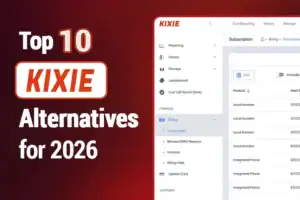The following article will explain what DNIS is in telecom, how it functions, what its benefits are, as well as the many use cases that can drastically improve the productivity and efficiency of a call center.
What Is DNIS in Telecom?
DNIS stands for Dialed Number Identification Service. It is a service offered by the telecom network provider that helps the call receiver to identify the number that the caller dialed.
How DNIS Works
It works by transmitting the dual-tone multi-frequency digits that the caller dialed to the destination where a special mechanism will decode the signals and either display them or make them available for use by devices at the receiving end.
This is especially useful for contact centers, where a PBX often receives calls dialed to different 800 or 900 numbers on the same port. The DNIS data would contain the dialed number, thus enabling the PBX to track the call. Integrating call processing and call routing with the associated data drastically improves the possibility for first call resolution and consequent customer satisfaction.
Combining technology and business processes is a key factor that determines the competitive edge of a contact center among its peers. Effective use of DNIS data enables contact centers to develop call handling, call routing, and monitoring processes based on the number dialed by the caller.
How Can DNIS Be Used?
Emphasis on Improving Call Center Metrics
- Agent performance is improved once the caller is profiled and assigned a campaign/ department to be routed to, based on the DNIS; customer satisfaction is increased by this assignment, as this diminishes the number of redundant questions they have to answer in regards to the scope of the call; along with that, FRC (first call resolution) rates increase as well
- As a result of the above, there is also a specialization of the agents in question, as they become dedicated to specific issues and/or different levels of the desired service. Once this happens, the possibility of over-investing in technology or human resources diminishes, as the productivity of each agent is maximized without having to compromise on the service level, as DNIS routing will guide the call to the appropriate/relevant groups. Sure, the abandoned calls rate might remain the same, but routing with DNIS will also help improve the amount of returned calls and increase the success rates of said calls, by giving the agent an indication of the initial service request.
- Segregating specific transactions requests; improving collection efforts by allocating different callback numbers based on the ‘aging’ of their dues or different collection tactics; being provided with DNIS data instead of asking it from the caller empower the agent to have a smoother, less mind-numbing interaction with the customer, which will eventually lead to building rapport and boosts overall satisfaction for all parties involved.
What’s fundamental when it comes to using the DNIS data is to enable the comprehensive segregation of groups and campaigns, customized with relevant factors.
Emphasis on Applicability
DNIS is an advantage for entities with high volumes of incoming calls, as routing them effectively would require outpulsing a phone number and adding priority settings for the returned calls to the same number. When doing that, IVR messages can be created for greeting or to increase the level of granularity a service request has, prior to reaching a live agent.
- Multilingual Customer Support ➡ directing through the number that was called and/or customer inputs on the IVR to the agent group with the appropriate language skill;
- Multiple Product Lines (queuing specific products and requests) ➡ routing to the correct skill group for specific transactions; having one single product is regularly a thing of the past and most companies offer a suite; passing a call from one agent to the other will only increase the average call time and keeping it as low as possible is crucial for a positive interaction;
- Analytical and Reporting tool (determines the effectiveness of advertisements made online, through billboards or word of mouth, through agent campaigns and upselling) ➡ if each of these mediums has a phone number assigned, their reach rate will be made obvious by the number of returned calls to each number, without having to ask additional questions to the caller. Taking this further, updating the counter on a data mining server can be done by using a VoiceXML application that tracks the DNIS info;
- Single Agent Multi-Client ➡ is very effective for BPOs that have a set of agents considered universal and a couple of projects for different customers, identifying the service associated with the caller prior to picking up will give the caller the impression he called his airline, for example, not a center that handles reservations for 20 different airlines.
DNIS Role in Streamlining Operations
Card Processing
DNIS data plays a central role in call processing, as one can define how the calls are routed and handled based on the number that was dialed. Customizations of it can be made with an IVR, using various criteria to filter the data and provide the following:
- IVR Menu options directing the caller to the appropriate groups;
- IVR options for self-service based on the service request group and automated info retrieval;
- Information about call status in the queue, waiting time for live agents, and additional info related to the service request; informational, greetings, hold music, queue position, etc.
Call Routing
The call routing strategy can also be informed through DNIS data, meaning that the server can decide, for example, if the call should be sent to a live agent or an IVR self-service menu. Also, DNIS + information on the actual skillsets of a group will direct a caller to the appropriate group, while analyzing the urgency/priority of said call and position for queuing.
Skill-Based Routing
A variation of this is skill-based routing, where calls are presented to all available agents with a given skill set, instead of queuing calls against an agent. In this scenario, the requirements can use, but are not limited to, the following parameters:
- Who the caller is/ Called Party information – CLID, ANI, NPA/NXX, trunk route, etc;
- Timestamp of the call;
- Queue parameters – length, priority, agent status, availability time;
- Caller inputs through IVR
Other Uses for DNIS
DNIS can also be used for:
- customized call scripting, where a call is directed to follow various predefined scenarios, based on DNIS data, caller input, NPA NXX, caller behavior, etc;
- customized data retrieval, where integration with a PBX and CRM (through CTI) leads to pulling the customer account and history based on CLID and DNIS;
- prioritization of calls based on the priority of the issue and the status of the customer, meaning that one can have premium customers or urgent issues that are directed to take lead in a queue with a given skill set;
- call recording, monitoring, and QA – calls from Platinum/Premium customers can be monitored and used for training.
I also wrote this article
Summing Up
All in all, DNIS can be used in a variety of ways, not limited to the ones mentioned above, that will enhance call center metrics. It impacts both the customer-facing levels of interaction and the performance and specialization of the call center operational level.
Routing Strategies
DNIS allows various groups to handle calls using different routing strategies by assigning a specific number to each strategy. DNIS data is rarely used alone, it is regularly combined with other sets of data to define optimal routing schemes based on the scopes of a group. Both routing schemes and routing data will have rule sets that can be configured in applications and configurations specific to the industry in which they are used.
Along with the above, monitoring all the moving parts and tweaking them to optimize the DNIS system is key in defining seamless customer interaction and process flows. Including all these configurations and their variations will also prove useful when it comes to the reports, agent performance, success rate of campaigns and departments, etc.
Adding DNIS and using it with all these data sets has actually led to a paradigm shift and fueled the transfer of the call center from the phone to an online-based environment, opened the road to excellence when it came to Customer Service, offered call centers at large a way to improve their performance, increase efficiency and lower costs.
How NobelBiz Uses DNIS
Other than that, DNIS has allowed NobelBiz to build tools that improve reach rates by offering a local presence, like Local Touch, our local caller ID solution, or that allow queuing customization based on customer profiles through phone number management portals, like SMRT. Both tools are part of our Voice Carrier Network services.
Irina T. has been working in the contact center industry for the past 10 years. After having an array of customer-facing roles, she joined the NobelBiz team in September 2018 as Provisioning Coordinator, that gave her access to a behind the scenes approach as well. This gave her the opportunity to contribute not only to the customer’s business, but also to the NobelBiz community.






